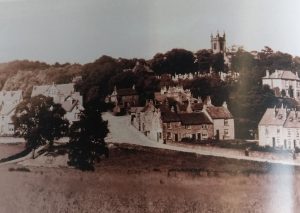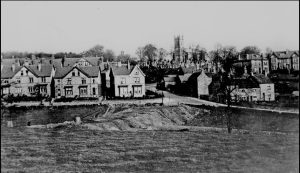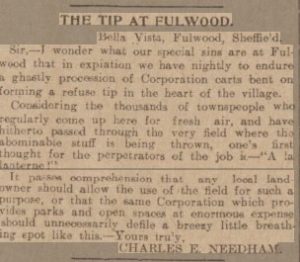 Signs of Fulwood becoming a suburb were evident by 1908. Crimicar Lane and Brookhouse Hill had new housing and Silver Birch was being developed. The photograph shows the junction in the early C20th, the foothpath that would be superceded by Brooklands Avenue is on the left and the houses, also on the left of the picture, are at the bottom of Crimicar Lane. The land for these houses had been purchased by Samuel Hancock from Henry Isaac Dixon of Stumperlowe Hall in 1905. The land in the west of Crimicar Lane drops away from Brookhouse Hill.
Signs of Fulwood becoming a suburb were evident by 1908. Crimicar Lane and Brookhouse Hill had new housing and Silver Birch was being developed. The photograph shows the junction in the early C20th, the foothpath that would be superceded by Brooklands Avenue is on the left and the houses, also on the left of the picture, are at the bottom of Crimicar Lane. The land for these houses had been purchased by Samuel Hancock from Henry Isaac Dixon of Stumperlowe Hall in 1905. The land in the west of Crimicar Lane drops away from Brookhouse Hill.
 The plans to create Brooklands Avenue were in existence at least from the early years of the new century: a plan of land being sold by Henry Isaac Dixon’s executors in 1913 shows the proposed road and the ramp is clearly shown on the picture of 1912 to the right.
The plans to create Brooklands Avenue were in existence at least from the early years of the new century: a plan of land being sold by Henry Isaac Dixon’s executors in 1913 shows the proposed road and the ramp is clearly shown on the picture of 1912 to the right.
 But the new residents of Fulwood valued its rural nature and the sight of rubbish being tipped did not go down well. The independent reported on the 18th March that ‘there is some protest which is growing’ over the use of refuse ‘of an objectionable kind’ being used for road building. Charles Needham, newly established in a villa opposite the church initiated the flurry of letters to the editor of the Daily Telegraph (the Idependent and the Telegraph were not averse to printing articles as direct copies of that found in their rival’s newspaper) . Needham’s letter was written soon after the tipping began and takes a swipe at Dixon as the landowner who had permitted and was being paid for allowing the tipping. T D Nichol was quick to support Needham, writing as soon as he read Needham’s letter. The rubbish being tipped was from households as the reference to ‘tined meat cans’ shows.
But the new residents of Fulwood valued its rural nature and the sight of rubbish being tipped did not go down well. The independent reported on the 18th March that ‘there is some protest which is growing’ over the use of refuse ‘of an objectionable kind’ being used for road building. Charles Needham, newly established in a villa opposite the church initiated the flurry of letters to the editor of the Daily Telegraph (the Idependent and the Telegraph were not averse to printing articles as direct copies of that found in their rival’s newspaper) . Needham’s letter was written soon after the tipping began and takes a swipe at Dixon as the landowner who had permitted and was being paid for allowing the tipping. T D Nichol was quick to support Needham, writing as soon as he read Needham’s letter. The rubbish being tipped was from households as the reference to ‘tined meat cans’ shows.
An Election Issue
October that year was a time of elections to the City Corporation and the candidates claimed and counter claimed as to who had ‘stopped the tipping of night soil’ with the Telegraph reporting that despite the claims of Coucillor Ashmore to this, it was in fact the landowner, Dixon, who had stopped the tipping. The independent, more supportive of Ashmore reported at length on his rebuttal of the earlier claims. There had been correspondence between Ashmore and the Town Clerk with the Clerk confirming that he had instructed.
The Telegraph investigated the matter, rather than relying on letters received and reports of hustings meetings, and on 29th October. Its report confirmed that James Dixon (son of Henry Isaac Dixon) had requested the tipping as he wanted the land raised to the level of the road. John Smith, living opposite at 84 Brookhouse Hill, was ‘indignant’ and complained the Health Committee, which had agreed to Dixon’s request, The Lord Mayor and the Town Clerk. In the end it was Dixon who stopped the tipping, probably because what was being tipped was more than he expected.
The barbs continued to be exchanged through the campaign. The election took place early in November and both Nowill and Ashmore were elected.
Brooklands Avenue Today
As to the ‘ramp’ that Dixon had initially instigated, it was eventually completed and became Brooklands Avenue. I suspect that most people who visit the shops at Fulwood are not aware that the Avenue is built up. However, the next time you visit the hardware shop (or any others on the same side) take a look a the paved area. There is a void underneath which can be seen between the vacant shop and the house. On the other side, the access to the garage drops away from the road.
And finally, T D Nichol whose letter to the Telegraph was featured in a Facebook page seems to be ficticious. I cannot find him an any census or street directories of the period. Neither can I find a reference to a house named Lynwood on Crimicar Lane.
But both Charles Needham and John Henry Smith definitely were ‘real’ and feature in the records
